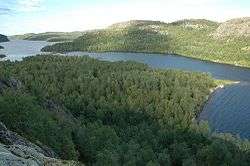Paatsjoki
The Paatsjoki River (Finnish: Paatsjoki, Skolt Sami: Paaččjokk, Northern Sami: Báhčaveaijohka, Norwegian: Pasvikelva, Swedish: Pasvik älv, Russian: Паз or Патсойоки, Paz or Patsoyoki) is a river that flows through Finland, Norway, and Russia. Since 1826, the river has marked parts of the Norway–Russia border, except from 1920 to 1944 when it was along the Finland–Norway border.[1]
| Paatsjoki River | |
|---|---|
 Harefossen and the Paatsjoki River | |
| Location | |
| Country | |
| Physical characteristics | |
| Source | |
| • location | Lake Inari |
| • coordinates | 68°53′30″N 028°22′00″E |
| • elevation | 118 metres (387 ft) |
| Mouth | |
• location | Bøkfjorden |
• elevation | 0 metres (0 ft) |
| Length | 145 km (90 mi) |
| Basin size | 18,344 km2 (7,083 sq mi) |
| Discharge | |
| • average | 175 m3/s (6,200 cu ft/s) |
The river is the outlet from the large Lake Inari in Finland and flows through Norway and Russia to discharge into the Bøkfjorden (which later flows into the Varangerfjorden and then the Barents Sea), not far from the town of Kirkenes. The river has a watershed of 18,404 square kilometres (7,106 sq mi), and is 145 kilometres (90 mi) long. A series of hydroelectric stations, known as the Paatsjoki River Hydroelectric Plants, are along the river.[1]
The river provides good fishing opportunities for Atlantic salmon, although fishermen must ensure that their fishing lines do not cross the international border.[1]
References
- Store norske leksikon. "Pasvikelva" (in Norwegian). Retrieved 2013-03-13.